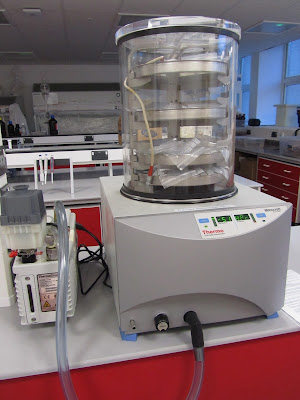I like intermediately long time scales! I prefer what science geeks like me know as Milankovitch time scales. The time scale on which the glacial-interglacial cycle fluctuates. Tens of thousends to hundreds of thousends of years. And the deep oceans have quite a splendid sediment archive of these times. The problem can be, though, that they're difficult to date. 14C only goes back ~50.000 years, and beyond that you have to be lucky to have something datable, such as volcanic ash, in your record. During my PhD I didn't. And then you have to rely on secondary information. You can see the glacial-interglacial cycle in your sediment, so you know roughly where you are, but if you want to correlate your records with equally unconstrained records from elsewhere you have a problem.
This job restricts itself to shorter time scales. But the good thing about that is: you can date away! 14C, 210Pb, 137Cs, the lot. Bring it on. And our 14C samples we send away, but the radionuclide work I do myself. In the CORiF lab. The idea of radionuclide dating is that you can detect things like bomb testing, and Chernobyl, in the sediment, and you know when that happened. Furthermore there's 210Pb; the idea is that natural radioactivity, in a way, rains down from the atmosphere onto the surface, and decays away with time. From how fast you lose your signal with depth you know how old your sediments are. Just to summarise it briefly.
So I'll be counting radioactive decay from my samples. And for that purpose, I have to slice up my core, weigh it, freeze-dry it, weigh it again, grind it to dust, jam as much of it as I can into a small plastic tube, and then wait for machine time. A lot of work! Especially if your core consists mainly of roots instead of mud. Try to mortar roots into powder! One needs lots of patience for that. But it's fun; I like playing with machines...
It's even good to keep in shape: the CORiF lab is on the 1st floor, while "our own" lab is on the eighth. And I have to do all the processing there, while I have to do all the weighing downstairs. The biggest gain was when, on a Friday, around 5PM, I wanted to weigh something, so I walked down, realised I didn't have access to the calibration weights, walked back up to store my samples, walked back down, bumped into a lady who was quite happy to open the door in question for me, so walked back up to get my samples, walked down to weigh them, and then back up to store them, and down because I was finished! If you are an isotope geochronologist you don't have to go running...
My samples in the freeze dryer
A dry sample
A ground sample (a nice and clean one)
My special upside-down-chisel technique to hammer as much material into that vial as I can
Before you can weigh anything, you have to calibrate the balance. With very cute little standard weights!
These are the big ones: 10, 5 and 1g. Below the white plastic slab there's the really small ones...







4 comments:
Kun je in die vriesdroger ook eten vriesdrogen? Of is dat wetenschappelijk niet verantwoord?
*ziet wandeltechnische mogelijkheden*
Ik denk niet dat ze dat op prijs zouden stellen! Waarschijnlijker dat ze me het lab uit lazeren...
Hm, dan maar gewoon doorgaan met de hardcore wetenschap. Moet ook gebeuren tenslotte. Interesaante stukjes over AGU trouwens.
Het is niet anders! En dank je!
Post a Comment